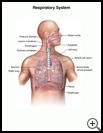
Respiratory Intubation, Non-Surgical
What is respiratory intubation and mechanical ventilation?
Respiratory intubation means a tube is put into your windpipe (trachea) to protect your airway and help you breathe. The tube will be placed through your mouth. It may be used to prevent fluid (such as mucus or saliva) from getting into your lungs. The tube may be attached to a breathing machine, called a ventilator, which moves air and extra oxygen into and out of your lungs. This is called mechanical ventilation.
You may need respiratory intubation and mechanical ventilation if you are not able to breathe on your own or get enough air and oxygen into your lungs when you breathe. This may happen after a major surgery, drug overdose, or if you have a severe injury or serious illness that keeps you from breathing on your own.
How is respiratory intubation and mechanical ventilation done?
Before the procedure:
- Your healthcare provider will ask you to sign a consent form for respiratory intubation if it is not an emergency. The consent form will state the reason you are having the procedure, what happens during the procedure, and what you may expect afterward.
- There is risk with every treatment or procedure. Talk to your healthcare provider for complete information about whether any of these risks apply to you:
- Anesthesia problems
- Bleeding
- Blood clots
- Infection
- Tell your healthcare provider if you have any food, medicine, or other allergies such as latex.
- Tell your healthcare provider if you are taking any medicines, including nonprescription drugs, herbal remedies, or illegal drugs.
- You will have a small tube (IV catheter) inserted into a vein in your hand or arm. This will allow for medicine to be given directly into your blood and to give you fluids, if needed.
During the procedure:
- You may be given a sedative through your IV to help you to relax.
- You will be given medicines to prevent pain during your surgery. These may include:
- Local anesthesia, which numbs your mouth and throat.
- General anesthesia, which relaxes your muscles and puts you into a deep sleep. It also keeps you from remembering the operation. While you are asleep, you will have a tube in your throat to help you breath and to make sure you are getting enough oxygen. The tube may be removed before you wake up after the surgery.
- The tube will be placed through your mouth. Your provider will use a tool that will help open your airway and guide the tube as it passes into your airway.
- Your provider may connect your breathing tube to a ventilator. The ventilator will help deliver oxygen into your lungs a set number of times per minute.
- Your heart rate and oxygen level will be monitored during the procedure.
After the procedure:
- You will be checked often by nursing staff.
- You will have blood tests to check the amount of oxygen and carbon dioxide in your blood.
- Your blood oxygen level will be monitored by a sensor that is attached to your finger or earlobe.
- Your provider may prescribe medicine to:
- Treat pain
- Help you relax or keep you from moving around too much and pulling the tube out
- Help relax your airways
- Reduce swelling in the airways
- Your provider may recommend other types of therapy to help relieve pain, other symptoms, or side effects of treatment.
- The breathing tube will stay in as long as you need it to protect your airway or help you breathe. Your provider will monitor your recovery to see if you can begin to breathe on your own.
- The ventilator settings may gradually be changed to allow you to do most of the work of breathing, with support from the ventilator as needed.
- The breathing tube will be removed if you are breathing well enough on your own and don’t need the support of the ventilator, or when there is no longer a need to protect your airway with the tube.
What can I do to help?
- You or your family will need to tell your healthcare team if you have new or worsening:
- Anxiety
- Chest pain
- Trouble breathing or feeling like you are not getting enough air
- Ask questions about any medicine, treatment, or information that you do not understand.
How long will I be in the hospital?
How long you stay in the hospital depends on many things, such as your general health, why you are in the hospital, the treatment you need, and how well you recover. Talk with your provider about how long your stay may be.
Last modified: 2016-04-29
Last reviewed: 2015-06-19

